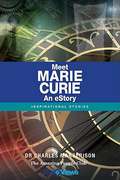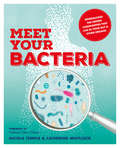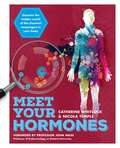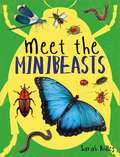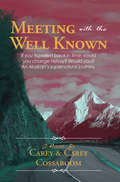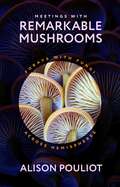- Table View
- List View
Meet Marie Curie - An eStory
by Charles MargerisonMeet Marie Curie! She was the first person in the world to be honored with two Nobel Prizes. Gain a unique insight into her amazing life and what actually inspired her. Get a personal insight into her relationship with her husband, Pierre. Be inspired by her amazing story as it comes alive through BioViews®?A BioView® is a short biographical story, similar to an interview. These unique stories provide an easy way of learning about amazing people who made major contributions to our world.
Meet Me in St. Louis
by Robert JacksonYou are holding a ticket to one of the largest and most magnificent celebrations of all time -- the 1904 St. Louis World's Fair! For seven months nearly twenty million visitors from around the globe flooded the fairgrounds of Forest Park. Many explored the twelve mammoth palaces (made of plaster and horsehair!), which showcased amazing exhibits. Others enjoyed watching the first Olympic Games in the United States, keeping cool all summer with a new treat that became an instant hit -- the ice-cream cone. And everyone loved viewing all 1275 acres of fairgrounds from atop the 265-foot Ferris wheel. Robert Jackson describes the planning, building, events, and memory of a fair that enthralled millions with its magic. In fascinating detail, he captures the energy and imagination of turn-of-the-century America, when fairgoers begged friends and family to meet them in St. Louis.
Meet Me in the Middle: A VeeFriends Book
by Gary VaynerchukNew York Times bestselling author, entrepreneur, and internet personality Gary Vaynerchuk gives kids a jump-start on getting ahead in Meet Me in the Middle, an all-original picture book featuring his beloved VeeFriends characters!With its unique two-in-one flip-book format, Meet Me in the Middle encourages young readers to see how different the world looks from another point of view. Start the book from the front and readers will learn about Eager Eagle’s day. Flip it over and readers will see the same story from Patient Pig’s perspective. It’s a fun story about how real success comes from seeing how the other side does it.Inspired by the lessons in the million-copy bestselling book Twelve and a Half, Meet Me in the Middle gives parents and educators a way to talk to kids about empathy, problem solving, and compromise—the essential keys to success, at any age!
Meet The Skeptic
by Bill FosterChristian faith almost always meets skepticism. Are you equipped to effectively handle the skeptic's questions and debates? Meet the Skeptic is a new approach to equipping believers to engage the non-believing culture. Author Bill Foster takes the multitude of objections and reduces them to four basic categories. Understanding these categories will enable you to effectively share your hope in the gospel of Jesus Christ and clarify the skeptic's root objection. Foster offers pop culture references and biblical support so that you can: Recognize the Red-Flag Words that prop up objections Ask probing questions and acquire an ear for opportunities Develop an understanding of the skeptics ideas and better fulfill the Great Commission. This easy to read approach to apologetics and evangelism is a field guide to faith conversations. It is written for teens, college students, and adults and can be used as a group study with the leader's guide and workbook.
Meet Your Bacteria (Meet your...)
by Catherine Whitlock Nicola TempleMeet Your Bacteria introduces you to all of your tiny tenants, and reveals the fascinating inner workings of your body, and the importance of these usually helpful (but sometimes harmful) microbes.Highly topical and accessible, this book:- Explores the different bacteria that live on and in various parts of your body (not just in the gut)- Explains what they do, and why some are beneficial and some harmful- Offers practical advice for promoting the good and inhibiting the bad bacteria- Examines the latest thinking on good and bad dirt, and the links between bacteria and diseaseIncluding in-depth profiles on each of the most important families of bacteria living in the human body, and helpful advice on how you can look after your own health through greater knowledge of your microbial friends, this is a wide-ranging introduction to the secret world inside your own body.
Meet Your Bacteria: The Hidden Communities That Live In Your Gut And Other Organs (Meet Your... Ser.)
by Catherine Whitlock Nicola TempleMeet Your Bacteria introduces you to all of your tiny tenants, and reveals the fascinating inner workings of your body, and the importance of these usually helpful (but sometimes harmful) microbes.Highly topical and accessible, this book:- Explores the different bacteria that live on and in various parts of your body (not just in the gut)- Explains what they do, and why some are beneficial and some harmful- Offers practical advice for promoting the good and inhibiting the bad bacteria- Examines the latest thinking on good and bad dirt, and the links between bacteria and diseaseIncluding in-depth profiles on each of the most important families of bacteria living in the human body, and helpful advice on how you can look after your own health through greater knowledge of your microbial friends, this is a wide-ranging introduction to the secret world inside your own body.
Meet Your Dog: The Game-Changing Guide to Understanding Your Dog's Behavior
by Kim Brophey&“Based on the latest findings in the field of canine cognition and behavior, this book is an invaluable resource.&” —Hal Herzog, author of Some We Love, Some We Hate, Some We Eat: Why It's So Hard To Think Straight About Animals Every dog owner knows that along with the joy can come the stress and frustration of behavioral problems, which are expensive to diagnose and treat. Enter Kim Brophey, award-winning canine behavior consultant. Using cutting-edge research, Brophey has developed a groundbreaking system that allows owners to identify what their dog is struggling with, why, and how they can fix it. Brophey&’s approach is unlike anything that has been published before and will give dog owners a new understanding of what motivates and affects their dog&’s behavior. This innovative technique rethinks the way we categorize dogs, and distills information from over twenty scientific disciplines into four comprehensive elements: learning, environment, genetics, and self. With revolutionary tips for specific dog breeds, this book will change dog owners&’ lives—and lead to happier human-canine relationships. &“It&’s refreshing to finally find a book that takes into consideration the many predispositions to behavior problems in dogs . . . teaches us to really see the dog in its entirety.&” —Alexandre Rossi, author of A Dog at the Keyboard
Meet Your Hormones (Meet your...)
by Catherine Whitlock Nicola TempleForeword by Professor John Wass, Professor of Endocrinology at Oxford UniversityDid you know that you have thousands, perhaps millions, of hormones in your bloodstream?Did you know that these complex chemical messengers regulate the function of our cells and organs?Or that they keep our bodies working properly, co-ordinating processes like growth, fertility and metabolism?Meet Your Hormones explores and explains the fascinating world of hidden hormones: what they are, what they do and why you can't live without these super-fast chemical messengers. Including in-depth profiles on each of the most important hormones at work in the human body, and helpful advice on how you can look after your own health through greater knowledge of your hormones, this is a wide-ranging introduction to the secret world inside your own body.This book:- Explores what hormones are, where they are made and how they work - Explains the key functions of the body in which they are involved - Offers practical advice on how we can help our hormones help us through diet and lifestyle - Examines the latest thinking and cutting-edge research - Forms a companion volume to Meet Your Bacteria
Meet Your Hormones: Discover The Hidden World Of The Chemical Messengers In Your Body (Meet Your... Ser.)
by Catherine Whitlock Nicola TempleForeword by Professor John Wass, Professor of Endocrinology at Oxford UniversityDid you know that you have thousands, perhaps millions, of hormones in your bloodstream?Did you know that these complex chemical messengers regulate the function of our cells and organs?Or that they keep our bodies working properly, co-ordinating processes like growth, fertility and metabolism?Meet Your Hormones explores and explains the fascinating world of hidden hormones: what they are, what they do and why you can't live without these super-fast chemical messengers. Including in-depth profiles on each of the most important hormones at work in the human body, and helpful advice on how you can look after your own health through greater knowledge of your hormones, this is a wide-ranging introduction to the secret world inside your own body.This book:- Explores what hormones are, where they are made and how they work - Explains the key functions of the body in which they are involved - Offers practical advice on how we can help our hormones help us through diet and lifestyle - Examines the latest thinking and cutting-edge research - Forms a companion volume to Meet Your Bacteria
Meet a Tarantula!
by Amy TaoDid you know that spiders are not insects? Insects have only six legs but spiders have eight. Unlike insects, spiders do not have antennae. Tarantulas may look terrifying, but they are relatively harmless to humans.
Meet the Cats (Meet The… #1)
by Kate PeridotGo on an around-the-world trip to meet eight of the world's most beloved big cats. Meet the cats that roar from the highest mountains, the hottest savannahs, and from the tallest trees in this brilliantly illustrated guide to eight species of the big cats. Explore the stunning landscapes where they live with a world map filled with big cat hotspots. Become an expert with fun feline fact files and a useful comparison chart - so you can see how the world's cats compare. Along the way, you'll even pick up tips on how to draw these clawesome carnivores!
Meet the Class (The Magic School Bus Rides Again)
by Samantha BrookeBuckle your seatbelts! The Magic School bus is ready to ride again—and kids can get to know Ms. Frizzle’s students in this colorful book.The Magic School Bus books took children on many adventurous field trips that taught them about science, inspiring an Emmy Award–winning animated show on PBS. Now Netflix has revived and updated the series for a new generation of kids.Meet Walkerville’s newest class with this introduction to The Magic School Bus perfect for young fans. Learn all about your favorite students from the original series like Keesha, Ralphie, D.A., and Arnold—plus a few new friends!
Meet the Minibeasts
by Sarah RidleyBecome a minibeast expert with this easy-to-understand guide to the wonderful and important creatures that live beside us. Have you ever wondered what the difference between a moth and a butterfly is? Or have you ever thought about how bees live together? This fascinating and comprehensive book for children aged 6+ is full of interesting facts and brilliant photographs. It also features guides to spotting your favourite minibeast in their natural habitats.Minibeasts covered: ants, aphids, bees, beetles, bugs, butterflies, centipedes, cicadas, crickets, damselflies, dragonflies, earwigs, flies, grasshoppers, harvestmen, millipedes, mites, moths, pond skaters, slugs, snails, spiders, termites, ticks, wasps, woodlice, worms.
Meet the Neighbors: Animal Minds and Life in a More-than-Human World
by Brandon KeimWhat does the science of animal intelligence mean for how we understand and live with the wild creatures around us? Honeybees deliberate democratically. Rats reflect on the past. Snakes have friends. In recent decades, our understanding of animal cognition has exploded, making it indisputably clear that the cities and landscapes around us are filled with thinking, feeling individuals besides ourselves. But the way we relate to wild animals has yet to catch up. In Meet the Neighbors, acclaimed science journalist Brandon Keim asks: what would it mean to take the minds of other animals seriously? In this wide-ranging, wonder-filled exploration of animals’ inner lives, Keim takes us into courtrooms and wildlife hospitals, under backyard decks and into deserts, to meet anew the wild creatures who populate our communities and the philosophers, rogue pest controllers, ecologists, wildlife doctors, and others who are reimagining our relationships to them. If bats trade favors and groups of swans vote to take off by honking, should we then see them as fellow persons—even members of society? When we come to understand the depths of their pleasures and pains, the richness of their family lives and their histories, what do we owe so-called pests and predators, or animals who are sick or injured? Can thinking of nonhumans as our neighbors help chart a course to a kinder, gentler planet? As Keim suggests, the answers to these questions are central to how we understand not only the rest of the living world, but ourselves. A beguiling invitation to discover an expanded sense of community and kinship beyond our own species, Meet the Neighbors opens our eyes to the world of vibrant intelligence just outside our doors.
Meet the Pollinators: A Night and Day Adventure
by Barbara CilettiThis vital and simply told story of pollination offers lush visual effects that illuminate their ongoing work by day and by night. Presented narratively, this title captivates young learners, emphasizing pollinators' vital role in our planet's survival. It conveys that even small creatures wield significant influence, illustrating pollinators' continuous journey for food. The intricate dance between pollinators and flowers is nature's wisdom in action. As flowers beckon, pollinators respond, playing a pivotal role in life's cycle. This dynamic exchange narrates the story of pollination, where pollinators fertilize plants while obtaining sustenance. Key Features: Engages young learners, emphasizing pollinators' life-giving role. Conveys that even small creatures make enormous Earth contributions. Educates about 24/7 global pollination value. Makes pollination understanding visual and accessible. Provides a closer look at pollination as a story. Includes additional teaching materials that enrich learning with pollinator bios, flower diagrams, and pollinator garden flower suggestions. This story underscores the importance of caring for Earth, highlighting its reciprocal response to positive stewardship.
Meet the Whales (Meet The… #1)
by Kate PeridotAn around-the-world trip to meet eight species of whale and learn all about them and their habitats. Includes a map of the world showing whale hotspots and a size comparison spread!
Meeting With The Well Known: If you travelled back in time, could you change history? Would you? An Alaskan's supernatural journey.
by Carey CossaboomI died in 1990, in an automobile accident in Alaska on the Seward Highway. Soon thereafter, I found myself sitting on the ground outside my home in south Anchorage. Only my home wasn't there. Actually, the whole subdivision was missing. Because I soon learned that it wasn't 1990 anymore; it was 1963. But how could that be? In 1963, I was a 9-year old boy living in upstate New York. How did I get here, and why? Could I get back the life I knew? I wanted my wife back! Meeting With The Well Known details my journey back to 1990 from 1963. The impossible circumstances, the delicate change of history, and the call of God to challenge the Church's misconception of time. An adventure so incredible, I dare not declare it as true.
Meeting at Grand Central: Understanding the Social and Evolutionary Roots of Cooperation
by Beth L. Leech Lee CronkA revolutionary approach to the study of cooperation that unites evolutionary biology and the social sciencesFrom the family to the workplace to the marketplace, every facet of our lives is shaped by cooperative interactions. Yet everywhere we look, we are confronted by proof of how difficult cooperation can be—snarled traffic, polarized politics, overexploited resources, social problems that go ignored. The benefits to oneself of a free ride on the efforts of others mean that collective goals often are not met. But compared to most other species, people actually cooperate a great deal. Why is this?Meeting at Grand Central brings together insights from evolutionary biology, political science, economics, anthropology, and other fields to explain how the interactions between our evolved selves and the institutional structures we have created make cooperation possible. The book begins with a look at the ideas of Mancur Olson and George Williams, who shifted the question of why cooperation happens from an emphasis on group benefits to individual costs. It then explores how these ideas have influenced our thinking about cooperation, coordination, and collective action. The book persuasively argues that cooperation and its failures are best explained by evolutionary and social theories working together. Selection sometimes favors cooperative tendencies, while institutions, norms, and incentives encourage and make possible actual cooperation.Meeting at Grand Central will inspire researchers from different disciplines and intellectual traditions to share ideas and advance our understanding of cooperative behavior in a world that is more complex than ever before.
Meeting the Energy Needs of Future Warriors
by Committee on Soldier Power/Energy SystemsThe central characteristic of the evolution of the combat soldier in recent years is an increasingly sophisticated array of sensing, communications, and related electronics for use in battlefield situations. The most critical factor for maintaining this evolution will be the development of power supply systems capable of operating those electronics effectively for missions up to 72 hours long. To address the challenge, it is important that new approaches be sought on how to integrate and power these electronics. To assist in addressing this problem, the Army requested the National Research Council to review the state of the art and to recommend technologies that will support the rapid development of effective power systems for the future warrior. This report presents the results of that review. It provides an assessment of various technology options for different power level requirements, power system design, and soldier energy sinks. The report also describes future design concepts, focusing on low-power systems. Recommendations for technology development and system design are presented.
Meeting the Family
by Donovan Webster Spencer WellsDonovan Webster brings his vivid journalistic gifts to a new subject, tracing our deep genealogy using cutting-edge DNA research to map our eons-old journey from prehistoric Africa into the modern world. With the same genetic haplotype as many white American males, Webster makes an ideal subject--he is a genuine Everyman. While his voice and spirit are unique to him, in exploring his own ancestry, he shows us our own.Drawing on National Geographic's Genographic Project, the largest anthropologic DNA study of its kind, Webster traces centuries of migrations, everywhere finding members of his now far-flung genetic family. In Tanzania's Rift Valley, he hunts with Julius, whose tribe speaks a click language, and wanders the ruins of ancient Mesopotamia with Mohamed and Khalid, now Jordanian citizens. In Samarkand, Uzbekistan, eastern frontier of his ancestral roaming, a circus ringmaster becomes both friend and link to his primal bloodline.Webster's genographic quest leads him to contemplate what traits he shares with those he meets, and considers what they and their ways of life reveal about the deep history of our species. A lifetime of journalistic travels among a wide range of cultures furnish Webster with a wealth of colorful threads to weave into a story as particularly personal as it is universally human.
Meeting the Family: One Man's Journey Through His Human Ancestry
by Donovan WebsterDonovan Webster brings his vivid journalistic gifts to a new subject, tracing our deep genealogy using cutting-edge DNA research to map our eons-old journey from prehistoric Africa into the modern world. With the same genetic haplotype as many white American males, Webster makes an ideal subject-he is a genuine Everyman. While his voice and spirit are unique to him, in exploring his own ancestry, he shows us our own. Drawing on National Geographic's Genographic Project, the largest anthropologic DNA study of its kind, Webster traces centuries of migrations, everywhere finding members of his now far-flung genetic family. In Tanzania's Rift Valley, he hunts with Julius, whose tribe speaks a click language, and wanders the ruins of ancient Mesopotamia with Mohamed and Khalid, now Jordanian citizens. In Samarkand, Uzbekistan, eastern frontier of his ancestral roaming, a circus ringmaster becomes both friend and link to his primal bloodline. Webster's genographic quest leads him to contemplate what traits he shares with those he meets, and considers what they and their ways of life reveal about the deep history of our species. A lifetime of journalistic travels among a wide range of cultures furnish Webster with a wealth of colorful threads to weave into a story as particularly personal as it is universally human.
Meeting the Universe Halfway: Quantum Physics and the Entanglement of Matter and Meaning
by Karen BaradMeeting the Universe Halfway is an ambitious book with far-reaching implications for numerous fields in the natural sciences, social sciences, and humanities. In this volume, Karen Barad, theoretical physicist and feminist theorist, elaborates her theory of agential realism. Offering an account of the world as a whole rather than as composed of separate natural and social realms, agential realism is at once a new epistemology, ontology, and ethics. The starting point for Barad's analysis is the philosophical framework of quantum physicist Niels Bohr. Barad extends and partially revises Bohr's philosophical views in light of current scholarship in physics, science studies, and the philosophy of science as well as feminist, poststructuralist, and other critical social theories. In the process, she significantly reworks understandings of space, time, matter, causality, agency, subjectivity, and objectivity. In an agential realist account, the world is made of entanglements of "social" and "natural" agencies, where the distinction between the two emerges out of specific intra-actions. Intra-activity is an inexhaustible dynamism that configures and reconfigures relations of space-time-matter. In explaining intra-activity, Barad reveals questions about how nature and culture interact and change over time to be fundamentally misguided. And she reframes understanding of the nature of scientific and political practices and their "interrelationship. " Thus she pays particular attention to the responsible practice of science, and she emphasizes changes in the understanding of political practices, critically reworking Judith Butler's influential theory of performativity. Finally, Barad uses agential realism to produce a new interpretation of quantum physics, demonstrating that agential realism is more than a means of reflecting on science; it can be used to actually do science.
Meeting the Universe Halfway: Quantum Physics and the Entanglement of Matter and Meaning
by Karen BaradThis is an ambitious book with far-reaching implications for numerous fields in the natural sciences, social sciences, and humanities. In this volume, Karen Barad, theoretical physicist and feminist theorist, elaborates her theory of agential realism. Offering an account of the world as a whole rather than as composed of separate natural and social realms, agential realism is at once a new epistemology, ontology, and ethics. The starting point for Barad's analysis is the philosophical framework of quantum physicist Niels Bohr. Barad extends and partially revises Bohr's philosophical views in light of current scholarship in physics, science studies, and the philosophy of science as well as feminist, poststructuralist, and other critical social theories. In the process, she significantly reworks understandings of space, time, matter, causality, agency, subjectivity, and objectivity. In an agential realist account, the world is made of entanglements of "social" and "natural" agencies, where the distinction between the two emerges out of specific intra-actions. Intra-activity is an inexhaustible dynamism that configures and reconfigures relations of space-time-matter. In explaining intra-activity, Barad reveals questions about how nature and culture interact and change over time to be fundamentally misguided. And she reframes understanding of the nature of scientific and political practices and their "interrelationship." Thus she pays particular attention to the responsible practice of science, and she emphasizes changes in the understanding of political practices, critically reworking Judith Butler's influential theory of performativity. Finally, Barad uses agential realism to produce a new interpretation of quantum physics, demonstrating that agential realism is more than a means of reflecting on science; it can be used to actually do science.
Meetings with Remarkable Mushrooms: Forays with Fungi across Hemispheres
by Alison PouliotA whirlwind journey through fungus frontiers that underscores how appreciating fungi is key to understanding our planet’s power and fragility. What can we learn from the lives of fungi? Splitting time between the northern and southern hemispheres, ecologist Alison Pouliot ensures that she experiences two autumns per year in the pursuit of fungi—from Australia’s deserts to Iceland’s glaciers to America’s Cascade Mountains. In Meetings with Remarkable Mushrooms, we journey alongside Pouliot, magnifiers in hand, as she travels the world. With Pouliot as our guide, we smell fire-loving truffles that transform their scent after burning to lure mammals who eat them and, ultimately, spread their spores. We spot the eerie glow of the ghost fungus, a deceptive entity that looks like an edible oyster mushroom but will soon heave back out—along with everything else in your stomach—if you take a bite. And we crawl alongside vegetable caterpillars, which are neither vegetable nor caterpillar but a fungus that devours insects from the inside out. Featuring stunning color photographs of these mycological miracles, Meetings with Remarkable Mushrooms shows that understanding fungi is fundamental for harmonizing with the natural world.
Meetings with Remarkable Mushrooms: Forays with Fungi across Hemispheres
by Alison PouliotA whirlwind journey through fungus frontiers that underscores how appreciating fungi is key to understanding our planet’s power and fragility.What can we learn from the lives of fungi? Splitting time between the northern and southern hemispheres, ecologist Alison Pouliot ensures that she experiences two autumns per year in the pursuit of fungi—from Australia’s deserts to Iceland’s glaciers to America’s Cascade Mountains. In Meetings with Remarkable Mushrooms, we journey alongside Pouliot, magnifiers in hand, as she travels the world.With Pouliot as our guide, we smell fire-loving truffles that transform their scent after burning to lure mammals who eat them and, ultimately, spread their spores. We spot the eerie glow of the ghost fungus, a deceptive entity that looks like an edible oyster mushroom but will soon heave back out—along with everything else in your stomach—if you take a bite. And we crawl alongside vegetable caterpillars, which are neither vegetable nor caterpillar but a fungus that devours insects from the inside out.Featuring stunning color photographs of these mycological miracles, Meetings with Remarkable Mushrooms shows that understanding fungi is fundamental for harmonizing with the natural world.
